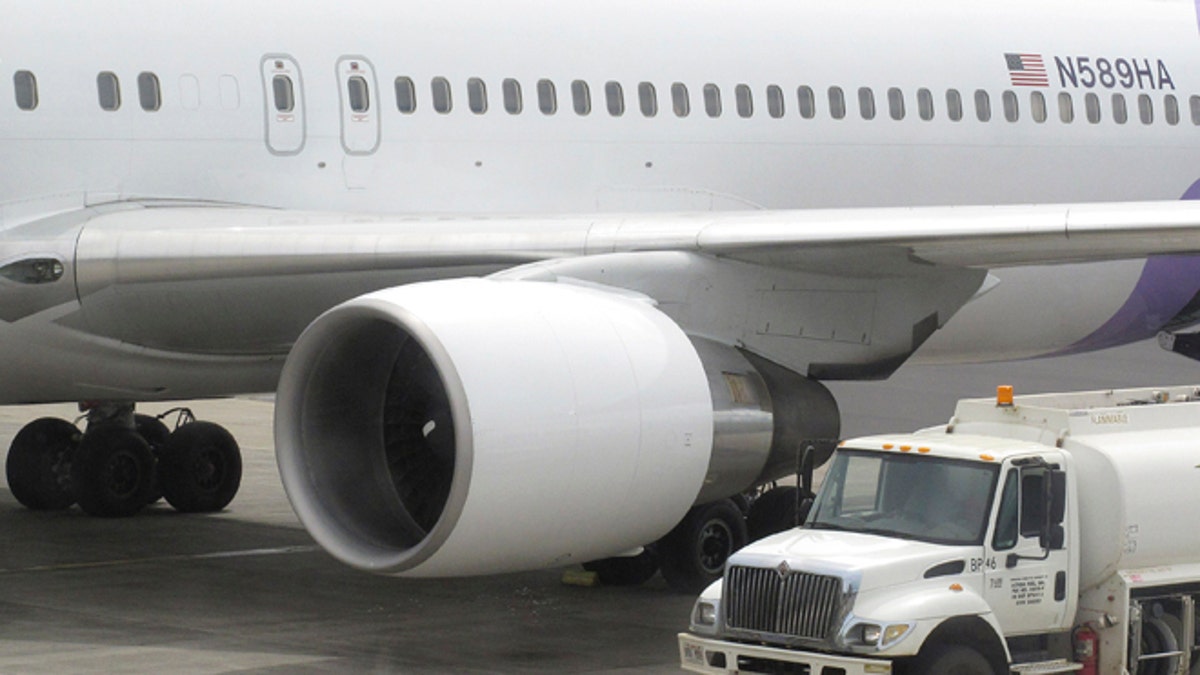
Hawaiian Airlines Flight 45 arrives from San Jose, Calif., in Kahului Airport in Kahului, Hawaii, on Monday, April 21, 2014. A 15-year-old boy on Sunday scrambled over an airport fence, crossed a tarmac and climbed into a jetliner's wheel well, then flew for five freezing hours to Hawaii on a misadventure that forced authorities to take a hard look at the security system that protects the nation's airline fleet. (AP Photo/Oskar Garcia)
The amazing and troublesome journey of a California teenager hidden inside a wheel well on a flight from San Jose to Honolulu seems like a miraculous, once-in-a-lifetime trip.
But a number of high-altitude stowaways have fooled both airlines and the odds of survival for decades.
Daring high-altitudes (the Hawaiian Airlines flight reached a cruising altitude of 38,000 feet), sub-zero temperatures (the young California boy endured temps of minus 30 degree Fahrenheit), and the huge risk when the wheels are lowered for landing, these stowaways have a very small success rate. Those that do make it to their destination alive have done so with strokes of dumb luck.
Worldwide, there have been 105 known people who stowed away since 1947, according to data kept by the Federal Aviation Administration. Counting the California teen, 25 made it alive, for a survival rate of about 1 in 4.
But the FAA notes that the rate may be lower because people could have stowed away and fallen out of the wheel well without anyone ever knowing.
One of the most famous successful stowaway attempts occurred in 1993 when a 13-year old boy hid in the wheel well of a Colombian cargo plane en route to Miami.
The stowaway, Guillermo Rosales, was found unconscious when the Arca Airline’s flight landed in South Florida and the flight crew began to inspect the DC-8 aircraft after its three hour, 1,000-mile flight from Bogotá. He was found balled up in the wheel well and covered in frost.
"He definitely should have died," Richard Ungerer, a mechanic told the New York Times then. "The wheel coming up could have crushed him, there's lack of oxygen at that altitude, and it had to be 20 or 30 degrees below zero."
So what kept this pint-sized passenger alive?
"The plane apparently has a pressurized wheel well, and that's why he survived," George Waldroup, a spokesman for the Immigration and Naturalization Service, the predecessor to Immigration and Customs Enforcement, told the Times. "He's a very lucky young man."
Other factors that lead to high-altitude survival are the presence of warm hydraulic lines in the wheel well and the initially warm tires that provide significant heat. Along with the hydraulic lines, a stable climb enables hypoxia that leads to gradual unconsciousness and as the wheel well environment cools, hypothermia accompanies the deep hypoxia, preserving nervous system viability and leaving the stowaway in basically a state of hibernation.
Being younger helps the chances of survival, though surgeons have tried to recreate this body state during surgery on older people.
Several doctors likened the body's experience in a wheel well on a long flight to what happens when someone falls under the ice of a frozen pond. They may have no pulse when they are pulled out, but could be revived.
"When it comes to hypothermia, all bets are off," said Dr. Jay Lemery, a professor at the University of Colorado specializing in emergency medicine in the wilderness. A body shut down by extreme cold should be "presumed alive, until they are warm and dead."
As the plane descends, the warmer temperatures and increasing atmospheric oxygen pressure slowly reduce hypoxia and hypothermia leaving most stowaways in a semi-conscious state.
Rosales’ successful, though unwise, escapade led to about a dozen copycat attempts in 1993 alone – to mixed results – and a slew of other attempts in the following years.
A popular departure airport for stowaways is Havana’s José Martí International Airport. Since Fidel Castro’s 1959 revolution, an unknown number of people have attempted to smuggle themselves off the island nation in the wheel well of an airplane.
In 1969, 17-year-old Armando Socarras Ramírez snuck into the wheel well of an Iberia Airlines flight from Havana to Madrid, avoided being crushed by the rising wheels and survived the cross-Atlantic flight to Spain. His friend, Jorge Pérez Blanco, who snuck into the other wheel well, is believed to have either fell to his death or been blown back on the runway by a jet blast and still be in Cuba.
“Doctors said later that my condition was comparable to that of a patient undergoing 'deep-freeze' surgery, a delicate process performed only under carefully controlled conditions,” Socarras Ramírez wrote, according to Altitude.org. “[Doctors] called my survival a 'medical miracle,' and, in truth, I feel lucky to be alive.”
The Associated Press contributed to this report.
Follow us on twitter.com/foxnewslatino
Like us at facebook.com/foxnewslatino
